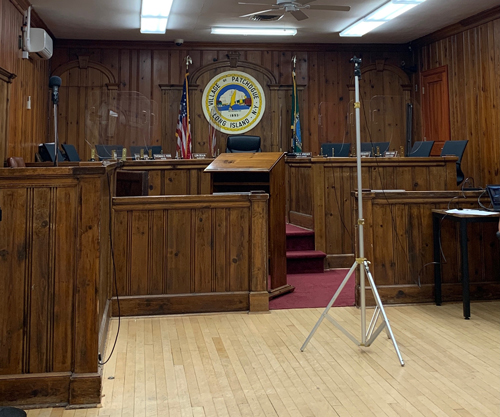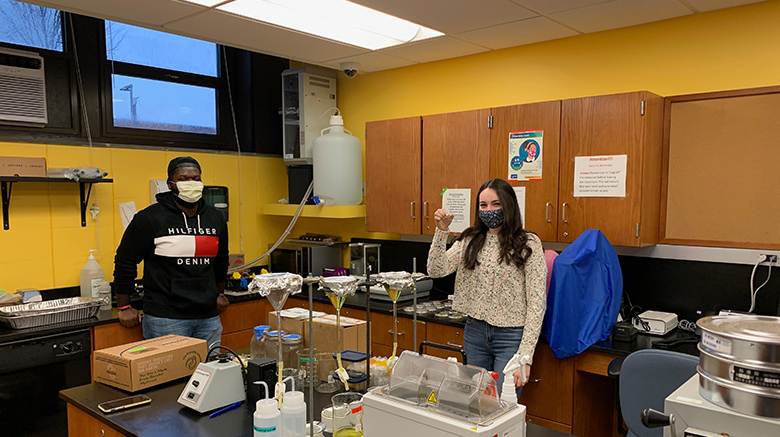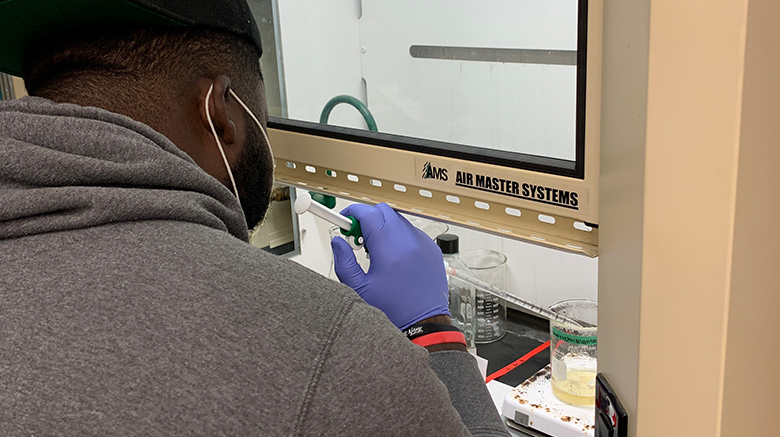Assistant Professor of Biology Konstantine Rountos, Ph.D., with the help of several biology majors at SJC Long Island, examined the concentration of microplastics in Patchogue River and the Great South Bay — something nobody has ever done before.
“Any environmental issues are of interest to me,” Dr. Rountos said as to why he started researching this topic. “Unfortunately, microplastics are now a growing and ever-present issue in our coastal waterways.”
Microplastics, which can come from synthetic clothing fibers, personal hygiene products and larger plastic containers that aren’t properly disposed of, are small pieces of plastic debris less than 5 millimeters in size that end up polluting bodies of water.
Dr. Rountos, who completed the project in collaboration with the Protect the Environment in Patchogue (PEP) Committee, presented his findings last week at the Patchogue Village Board meeting.
“By presenting this to the mayor and the trustees, they were able to see firsthand what a collaborative citizen project could reveal, and also provide them and our broader community with some information about these contaminants that are in our local waterways,” said Dr. Rountos, coordinator of the environmental studies minor at SJC Long Island.
Dr. Rountos is also planning on going to local elementary and middle schools to talk to students about microplastics, how they impact our ecosystem, and how to help make a difference.
Studying Local Waters
The project of collecting and studying microplastics was a collaborative effort between members of the biology department, the Sustainability Committee at SJC Long Island, PEP, the National Park Service and community volunteers.
“Having a baseline (for the concentration levels) is an important first step, and this pilot study was able to give us enough information to show that we still have a lot of questions remaining that should be explored and should be examined in the future,” Dr. Rountos said.
Two members of the Class of 2021, Christian Fouche and Molly Feinburg, did their senior research on studying the microplastics found in the local water. Three current students are building on this research, one looking at microplastics in the sand on Fire Island and the others checking to see if there are microplastics in our filter-feeding organisms, such as clams or oysters.
The pilot study testing the concentration of microplastics revealed that there’s a higher level of concentration in the Great South Bay than the Patchogue River, and that 85% of the collected particles were green-colored fragments of larger plastic containers.
“Our society was able to survive and thrive before plastics were invented,” Dr. Rountos said. “So we can change our habits, maybe modify our behavior a bit and change our expectations, in order to achieve a common good and reduce the amount of plastic pollution in our waterways.”
Working Together to Make a Change
Dr. Rountos offered four tips to help prevent further microplastic pollution in our local waterways:
1. Switch to an aluminum or stainless-steel, reusable water bottle.
“Over the course of a year, this can save a lot of single-use water bottles from going into the waste stream,” Dr. Rountos said. “Even if you’re a person who recycles those bottles diligently — which not everyone does — those products could still end up in our environment because of inefficiencies in the recycling process.”
2. If you see plastic on the ground when you’re out for a walk or on the beach, pick it up if it’s safe to do so.
“Lead by example,” Dr. Rountos said. “If somebody sees you doing this, maybe they’ll be inspired to do the same. If everyone does this, then we can all improve our environment. Just remember to wear gloves and don’t go into areas that are dangerous.”
3. Try your hardest to not use plastic products.
“Don’t use isolated plastic bags for fruits and veggies at the grocery store,” Dr. Rountos advises. “Switch to reusable soap containers and containers for cleaning products. Try not to use things that will just add to the plastic waste that we’re accumulating.”
4. Avoid fast fashion and check your clothing labels.
“The fashion industry itself is a large polluter,” Dr. Rountos said. “Clothing that’s not 100% cotton or wool contains synthetic fibers, which add to the levels of microplastics in our waters. Consider maybe buying things secondhand where possible. Reducing our global consumption for fashion certainly could help.”





